We are building on past investment to find better solutions to combat some of Australia's worst established pest animals and weeds.
To help protect Australia’s agriculture and our environment against pests, this program is investing $30.3 million to provide lasting legacy to farmers, land managers and the wider community through:
- National coordination
- Better information
- Research and Development
- On-ground control
Bringing together industry, governments, natural resource management groups and the wider community we are delivering a national approach to pest animal and weed management. We are supporting the expansion of more coordinated management activities and improvements to information sharing through:
- a National Feral Pig Management Coordinator Program. This has led to the development of the National Feral Pig Action Plan ($1.4 million through Australian Pork Limited).
- building on the previous WoNS initiative, improvements to the coordination and management of priority weeds. A National Established Weed Priorities (NEWP) framework has been developed, and best practice manuals are being developed for WoNS such as cat’s claw creeper, Madeira vine, sagittaria, gamba grass, fireweed and African boxthorn ($1.1 million to Wild Matters Pty. Ltd.)
To gain a better understanding of the impacts of established pest animals and weeds on Australia’s agriculture and environment, we have or are funding:
- ABARES to undertake three projects to improve our understanding of the distribution, economic and social impacts of pests and weeds in Australia ($2.2 million)
- CSIRO to explore the possibility of identifying different populations of feral pigs in Australia using DNA samples ($160,000)
- CSIRO to continue research into a biological control option for fireweed ($291,500)
- University of Queensland to undertake further research into herbicides to target WoNS ($299,830)
We are funding research to find innovative solutions for priority established pests and weeds of national significance.
Through the Advancing Pest Animal and Weed Control Solutions competitive grant round, $13 million has been committed to fund 19 successful projects. These projects will further research and develop control solutions such as biological controls, genetic modification and advanced automation technologies.
Project outcomes will deliver new and enhanced ‘farm ready’ control tools for over 45 of Australia’s most invasive pest species, including fall army worm, hive beetle, lantana, prickly acacia and cane toads. $12 million in additional cash or in-kind support will add great value to the delivery of the projects and increase uptake and accessibility of tools by farmers and land managers.
Successful projects - Advancing Pest Animal and Weed Control Solutions Competitive Grant Round
| Project detail | Lead recipient | Consortium partners | Up to value ($, GST exclusive) |
|---|---|---|---|
| Diversification of weed management through cultural burning, utilising traditional knowledge to target herbicide resistance. | Balonne Shire Council | N/A | $744,746.31 |
| Weed managers guide to remote detection. Understanding opportunities and limitations of multi-resolution and multi-modal technologies for remote detection of weeds in heterogeneous landscapes. | Charles Sturt University | New South Wales Department of Planning, Industry and Environment Queensland University of Technology Local Land Services - Murray Local Land Services - North Coast Local Land Services - South East Mid Coast Council Eurobodalla Council Bega Valley Shire Council Illawarra District Weeds Authority XAG | $589,525.00 |
| Developing new novel biopesticides for the control of fall armyworm. | CSIRO | N/A | $548,634.00 |
| Optimising the use of biological agents for the control of invasive cacti in Australia through a variety of integrated approaches. | Queensland Department of Agriculture and Fisheries | N/A | $389,660.00 |
| Research into new aquatic herbicides to develop improved aquatic weed management tools. | Queensland Department of Agriculture and Fisheries | N/A | $550,000.00 |
| Improving the efficiency of rabbit haemorrhagic disease virus releases through testing two novel methods of virus delivery to rabbits. | Department of Regional New South Wales | South Australian Department of Primary Industries and Regions Commonwealth Scientific and Industrial Research Organisation (CSIRO) | $665,855.00 |
| Research and development into innovative grain refrigeration processes, to disrupt breeding of established grain pests in response to resistance to grain insecticides. | Graincorp Operations Limited | Queensland Department of Agriculture and Fisheries | $740,661.00 |
| Applying environmental DNA (eDNA) methods for yellow crazy ant detection, a sensitive and less labour-intensive approach to invasive ant detection. | James Cook University | Invasive Species Council Inc. Townsville City Council | $629,505.00 |
| Improvement of control methods for small hive beetles through novel trapping and bio attractant tool developments. | Macquarie University | N/A | $379,293.60 |
| Developing insecticide resistant beneficials for integrated pest management. | Macquarie University | New South Wales Department of Primary Industries | $974,848.30 |
| Development of a machine learning-based platform for fast invasive ant detection and recognition. | Murdoch University | Queensland Museum James Cook University CSIRO | $791,882.00 |
| Non-toxic pest control tool for established fall armyworm (FAW) in Australia without the risk of resistance development. | Murdoch University | Advanced Transmission Systems Holdings Ltd | $446,050.40 |
| Weed genomics to advance lantana control, with lab-to-farm improvements in biotype identification and control agent matching tools. | Royal Botanic Gardens and Domain Trust | Macquarie University Queensland Department of Agriculture and Fisheries CSIRO Michael Day | $392,803.29 |
| Autonomous machinery to replace herbicide for under-vine weed control. | The Australian Wine Research Institute Limited | Pernod Ricard Winemakers Pty Ltd | $669,850.00 |
| WeedOmics - development of a next generation molecular diagnostic testing platform to test for herbicide resistance. | The University of Melbourne | Grains Research and Development Corporation | $351,792.00 |
| Development of broadly applicable technologies essential for the future production of suppression gene drives to eliminate invasive pest populations of multiple vertebrate species, including fishes and the cane toad. | The University of Melbourne | N/A | $1,390,545.00 |
| Developing an intelligent sprayer with lidar for the detection and automated application of basal bark, soil-applied and foliar-applied herbicides to prickly acacia. | The University of Queensland | Desert Channels Queensland Inc Silvan Australia | $438,501.00 |
| Developing targeted tillage weed control in row-cropping systems. | The University of Western Australia | The University of Sydney Precision Agronomics Australia AgMaster David Nowland Hydraulics Grains Research and Development Corporation Dalby Rural Supplies Facey Group Corrigin Farm Improvement Group | $1,998,474.00 |
| Managing Ips grandicollis bark beetles through anti-aggregation pheromones, development of a new control tool. | University of the Sunshine Coast | HQ Plantations Pty Ltd Forestry Corporation of New South Wales National Sirex Coordination Committee Queensland Department of Agriculture and Fisheries University of Georgia, USA | $307,374.10 |
| Total | $13,000,000.00 |
Grant Opportunity Guidelines can be viewed below.
Download
Established Pest Animals and Weeds Management Pipeline Program - Advancing Pest Animal and Weed Control Solutions Competitive Grant Round Grant Opportunity Guidelines (PDF 739 KB)
Established Pest Animals and Weeds Management Pipeline Program - Advancing Pest Animal and Weed Control Solutions Competitive Grant Round Grant Opportunity Guidelines (DOCX 508 KB)
If you have difficulty accessing these files, visit web accessibility for assistance.
We provide support to state and territory governments who are responsible for the on-ground management of pest animals and weeds. We are currently funding:
Wild dog fencing
$1 million to both South Australia and Western Australia in 2019–20 for their state wild dog fencing projects. The funding to South Australia, together with $9 million from other Commonwealth sources, delivered on the $10 million election commitment to the South Australia wild dog fence project, from 2019–20 to 2022–23.
Prickly Acacia Weed Management program
Prickly acacia (Vachellia nilotica) is a Weed of National Significance (WoNS). It is regarded as one of Australia’s worst weeds because it:
- spreads rapidly;
- reduces available pasture for livestock;
- damages soils by facilitating erosion;
- interferes with mustering, livestock movement and access to water; and
- threatens biodiversity through the transformation of natural grasslands into thorny scrub and woodland.
In 2019, the North Queensland floods washed prickly acacia seeds downstream, potentially increasing the distribution of the weed into areas that were not yet infested. As part of the North Queensland flood recovery effort, the Australian Government committed $5 million over five years (2019-20 to 2023-24) to reduce the impact of prickly acacia on primary producers and the environment in affected areas of north-western and central-western Queensland.
The funding is being provided to three natural resource management (NRM) groups to undertake on-ground weed management and control, surveillance, community extension and awareness raising activities.
Final reports have been submitted and are under review by departmental officers.
Prickly Acacia Weed Management program funding allocation
| NRM Group | Total funding allocation |
|---|---|
| Desert Channels Queensland Inc. | $2,600,000 |
| Gulf Savannah NRM | $350,000 |
| Southern Gulf NRM Ltd. | $2,050,000 |
| TOTAL | $5,000,000 |
$5 million to state and territory governments through a Federation Funding Agreement.
We have partnered with state and territory governments to improve the skills and capacity of land managers and communities to better manage established pest animals and weeds.
We have allocated $5 million over three years to fund projects investigating research, adoption, coordination and extension. Each of the 11 successful projects are supported by co-contributions from the relevant state or territory government.
New South Wales
Funding: $930,354
Future-proofing Australia’s National Post-Border Weed Risk Management System
- Target species: All weeds
- Key activities: Development of a national, standardised, web-based weed risk assessment system to assist land managers to assess weed risk and prioritise management actions. This project aims to develop a weed risk assessment tool that improves existing systems by incorporating post- disturbance risk capability (e.g. fire, drought) and allows for more effective use of existing weed response and trait data to inform weed risk management prioritisation. Additionally, this project will develop decision support tools for land managers to allow a priori decision making and integration of management objectives into existing planning systems.
National Invasive Grasses Research, Development & Engagement Business Plan – Stage 2 Adaptation and Coordination in NSW
- Target species: Serrated tussock, Chilean needle grass, African lovegrass
- Key activities: This project sought to reduce the impact of invasive grasses in NSW by implementing stage 2 of the National Invasive Grasses Research, Development & Engagement Business Plan, building on stage 1 which saw the establishment of three NSW demonstration sites for the management of invasive grasses. This project appointed two NSW invasive grasses coordinators to oversee the establishment of 21 demonstration sites (7 per species) hosted and co-designed by land managers across NSW. Training was provided at these sites to improve the knowledge base of NSW land managers in best practice management methods and tools for each of the target weeds. Technical staff from Stage 1 of the Invasive Grasses Project (funded through the Centre for Invasive Species Solutions) formed part of the Project Steering Committee for this project.
- Completed May 2023
Northern Territory
Funding: $500,000
Advancing the detection, control and management of Siam weed in northern Australia
- Target species: Siam weed
- Key activities: This project sought to reduce the threat that Siam weed poses to northern Australia by supporting land managers to contain and eradicate the single infestation site in the Northern Territory, and to address identified gaps in the development and implementation of best practice management. To achieve this, a project officer was tasked with building land manager capacity to identify, survey and control Siam weed as part of a long-term strategy for containment and eradication, advancing a new cost-effective, catchment-scale surveillance method, and developing a Siam Weed Management Guide (which has been distributed to the National Siam Weed Work Group)
- Completed January 2024
Queensland
Funding: $998,000
Biological and chemical approaches to ‘on-farm’ management of the invasive weed, Navua sedge
- Target species: Navua sedge
- Key activities: This project focuses on research, development and extension (RD&E) activities that will offer innovative solutions for holistic management of Navua sedge. RD&E activities will include research into classical biological control agents and the development of mycoherbicides (fungal-based herbicides), and assessments of the efficacy of conventional herbicide control techniques. Results of this research will be extended to landholders through field days and demonstration sites to improve the on-ground management of Navua sedge.
Enhancing feral pig management in northern Australia – validation through demonstration of optimised management
- Target species: Feral pigs
- Key activities: This project aimed to improve the management of feral pigs in northern Australia by appointing a feral pig management coordinator to establish demonstration sites for field validation of optimised monitoring and control strategies. This research was required before widespread adoption of these approaches could be recommended. Best-practice management guidelines for feral pig management relevant to northern Australia have been reviewed and updated.
- Completed April 2024
South Australia
Funding: $740,000
Coordinated control of established pest animals and unpalatable perennial grasses through community-led action
- Target species: Feral deer, rabbits, foxes, unpalatable perennial grasses
- Key activities: This project sought to improve management outcomes for rabbits, deer, foxes and unpalatable perennial grasses in South Australia by extending the successful community-engagement model currently used in South Australia for rabbits, deer, wild dogs and weeds. This project fostered collaboration between stakeholders, establishing landholder management groups, coordinating control programs, supported the uptake of new technologies, and delivered information through workshops and training.
- Completed April 2023
Coordinated capacity building for Aboriginal Land Managers to control Weeds of National Significance and other high priority established weeds
- Target species: Athel pine, African boxthorn, opuntioid cacti
- Key activities: Through a program coordinator, this project aimed to build the capacity of Indigenous land managers to reduce the impact of target WoNS on remote Indigenous land in South Australia. The coordinator worked with Indigenous communities to provide advice on best practice management, emerging technologies and invasion pathways, coordinate workshops and training, and develop priorities for weed issues at the local level.
- Completed April 2023
Tasmania
Funding: $495,546
Coordinated action to support landowners to improve agricultural productivity and protect significant environmental values from the impacts of highly invasive perennial grasses, including Nassella grass species
- Target species: Chilean needle grass, serrated tussock, Mexican feather grass, Texas needle grass
- Key activities: This project built on a project funded through the Australian Government’s Agricultural Competitiveness White Paper that focussed on building the capacity of landowners affected by Nassella species and highlighted the need for a more coordinated management approach. This project sought to update existing property plans and develop new ones to manage the Nassella grasses, with a focus on developing plans encompassing multiple properties to achieve landscape-scale outcomes. Additional activities included updating distribution and abundance data, development of an educational package and undertaking formal risk assessments.
- Completed March 2024
Victoria
Funding: $880,000
Indigenous Facilitator for the management of pest and weeds in culturally sensitive landscapes
- Target species: Rabbits, gorse, blackberry, serrated tussock
- Key activities: This project appointed an Aboriginal Cultural Heritage Coordinator who worked with Traditional Owner groups to co-design a guide for managing established invasive species in culturally sensitive areas. This guide included a decision-making matrix with an agreed methodology that will be extended for use by both public and private land managers, allowing for more effective landscape-scale outcomes whilst building awareness of Aboriginal heritage throughout Victoria.
- Completed December 2023
Advancing feral pig management in Victoria – coordination and community
- Target species: Feral pigs
- Key activities: This project sought to apply a community-based, cross-tenure approach to feral pig management, supported by a dedicated Victorian Feral Pig Coordinator. The coordinator was responsible for conducting system mapping to identify key stakeholders, current management programs, levels of knowledge and funding flows. Other responsibilities included establishing feral pig working groups, developing and delivering training and resources to support feral pig awareness and control, and facilitating connections between on ground control and feral pig research projects.
- Completed June 2024
Western Australia
Funding: $445,800
Establishing a landscape scale wild dog and feral pig monitoring network to improve delivery of coordinated and effective pest management.
- Target species: Wild dogs, feral pigs
- Key activities: This project sought to increase the capacity of the three Recognised Biosecurity Groups in the northern agricultural zone to detect and mount timely and effective responses to wild dogs and pigs. This was achieved by establishing an expansive remote camera trapping surveillance network, incorporating the latest technology to enable wireless upload of data and AI software data analysis.
- Completed May 2024
Case studies
The Australian Wine Research Institute and Pernod Ricard Winemakers (now Vinarchy) partnered to test how well autonomous tractors and robots could manage under-vine weed control in Barossa vineyards. The systems were trialled over two years using a range of attachments, including mowing and cultivation tools.
The team fitted a tractor with an autonomy kit and compared its performance to an autonomous robot. The vehicles and attached implements were modified to suit operation in Australian vineyards. The project also tested safety systems designed to stop operations and send alerts when problems occurred. Basic LIDAR sensors often struggled under large vine canopies and in long grass. In contrast, an AI-powered camera was more reliable for long term operation. It could detect people and obstacles with higher accuracy for sustained safe operation. A key learning from the project was that the tractor with the autonomy kit was more robust than the robot. Farmers can use it with existing farm implements with small modifications. The system also allowed manual control when needed, offering flexibility for field operations.
Mechanical weed management under vines is generally more expensive than using herbicides. However, it can be more affordable when paired with autonomous technology that can be used for canopy spraying and mid-row mowing. A tractor with an autonomy-kit has this capability.
Autonomous farm vehicles generally have a LIDAR or camera and one or more bump sensors. But it is recommended that workers are not in the same block while equipment is operating. Displaying the warning signs at key access points is also recommended. There are no specific Australian laws regulating the use of autonomous vehicles on private properties. But existing laws regarding work safety still need to be observed.
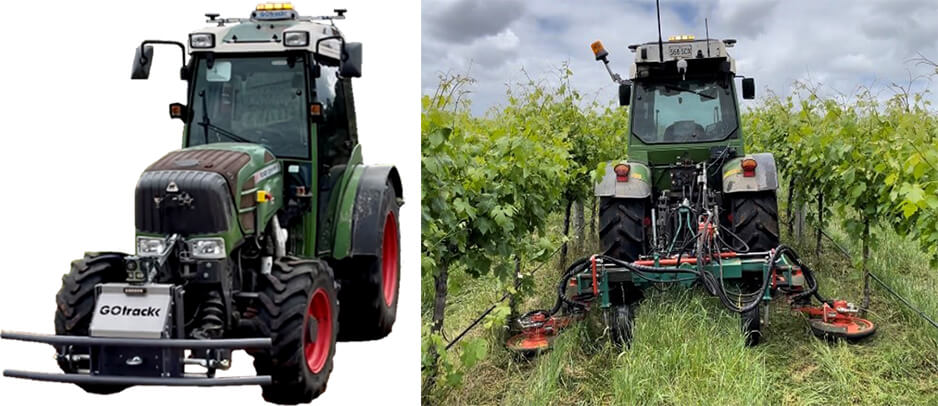
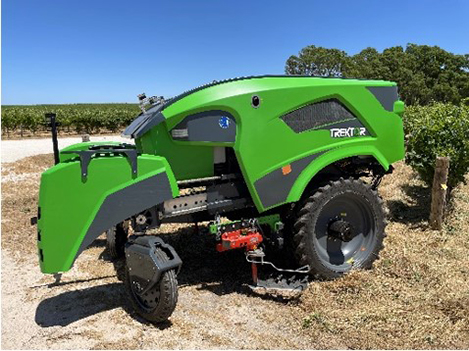

The team organised demonstrations of the test vehicles and other autonomous vehicles in the Barossa Valley. They also shared findings with grape growers across various locations. This increases the awareness of the potential benefits of autonomous vehicles. This included a workshop at the 2022 Australian Wine Industry Technical Conference.
This project demonstrated that automation can be scalable. It offers a cost-effective solution for vineyard weed control. Expanding the use of autonomous tools tailored for the vineyard conditions could transform weed management across Australia.
The project was partially funded by the department’s Established pest animals and weeds management pipeline program. For more information contact the Environmental Biosecurity Office.
The Queensland Department of Primary Industries worked with landholders at two major demonstration sites: Westmar in southern Queensland and Collinsville in northern Queensland. The main goal was to improve monitoring and control methods for feral pigs. The results helped update management guidelines for effective management across northern Australia.
The project monitored feral pig populations before and after aerial shooting. Data was collected using aerial surveys, remote cameras, and GPS tracking. Results showed, aerial shooting reduced feral pig numbers by up to 82 percent at the Westmar site.
To study behaviour after aerial culling, some feral pigs were fitted with GPS collars. Researchers tracked these pigs to see if the aerial shooting changed their behaviour or movement. They found that aerial culling did not significantly disturb the pigs. There were no major changes in their behaviour, home range sizes, home range location, or home range overlap.
These findings improved feral pig management and monitoring strategies in northern Australia. They also helped develop effective aerial shooting programs.
An updated factsheet with best practice guidelines is now on the Queensland Department of Primary Industries website. The project findings were also presented at the 19th Australasian Pest conference. At this event, Dr Catherine Kelly talked about "Variable responses to aerial control." She discussed how feral pigs behave in response to aerial shooting.
The research collected GPS data from 146 collared feral pigs across various locations. This data informed the research article on "Quantifying feral pig interactions to inform disease transmission networks." This study also showed that sex and seasonal conditions can increase disease outbreak risks in feral pig populations.
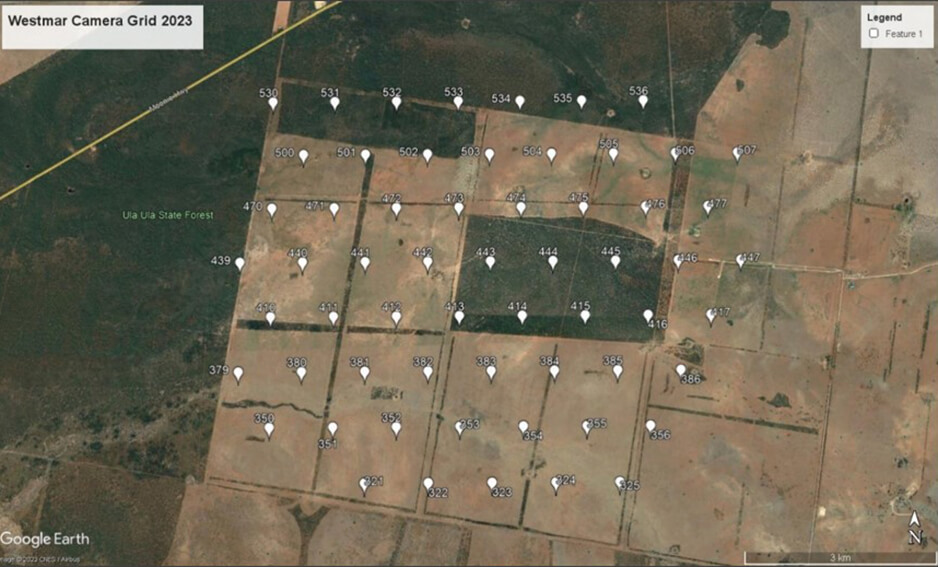
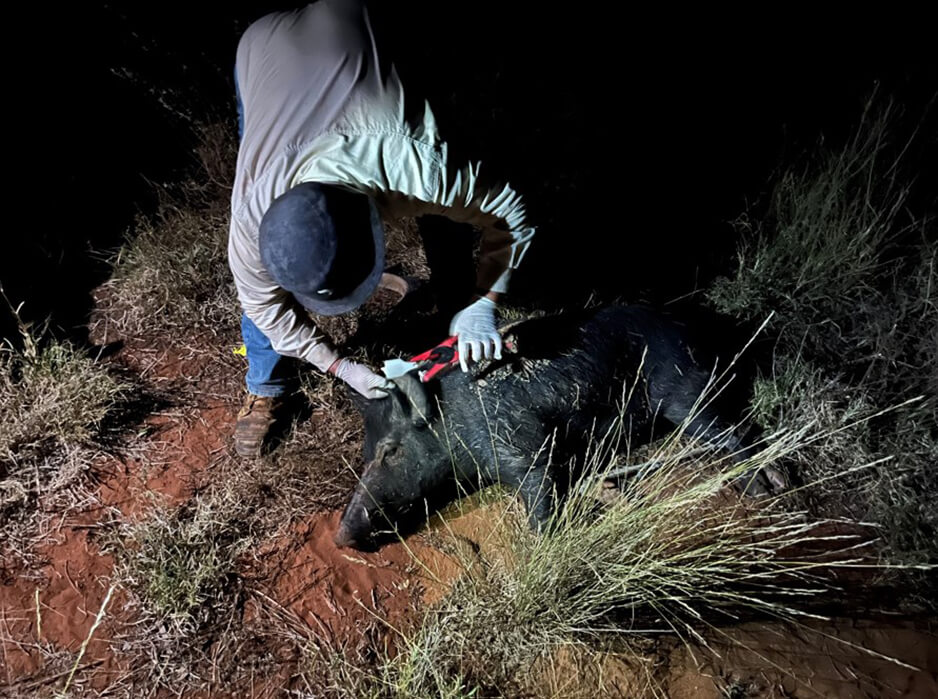
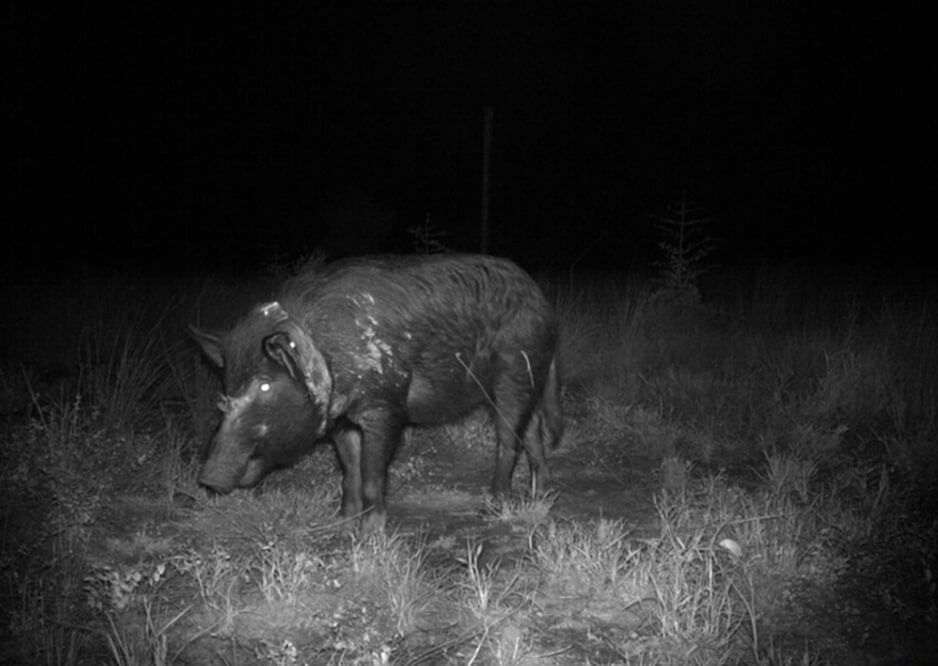
Further research has continued at Collinsville, Queensland. The focus is on using a thermal camera to improve the detection of feral pigs in aerial shooting. A comparison between non-thermal aerial shooting and thermal methods is being conducted. The cost effectiveness between these two methods studied. It will provide further information to optimise management techniques under northern Australian conditions.
The project was partially funded by the department’s Established pest animals and weeds management pipeline program. For more information contact the Environmental Biosecurity Office.
Storage grain pests pose a major threat to both domestic and international grain markets in Australia. Fumigants are widely used to control these pests, but many insects are now becoming resistant.
GrainCorp and Queensland Department of Agriculture and Fisheries (QDAF) began a study to test if refrigeration, when used with fumigation, could better manage pest resistance. This work marks important step forward for Australian grain industry.
The new method cools stored grain to below 15°C. This temperature disrupts the respiration and reproductive cycles of pests. Most pests prefer warm conditions between 25°C and 35°C, so cooling helps interrupt their life cycles.
Phosphine and sulfuryl fluoride are the most common storage fumigants. These gases complement each other, with sulfuryl fluoride helping to control pests that have developed resistance to phosphine. The team experimented with different fumigation protocols for phosphine and sulfuryl fluoride. They trialled protocols at three temperatures (15, 18, and 21°C). The goal was to control all life stages of two highly resistant species — the Rice weevil and the Rusty grain beetle (Figure 1). Commercial-scale testing was also at a GrainCorp storage site. This was done using two chiller units connected to concrete silos (Figure 2).
Field trials at lower temperatures (15–21°C) showed complete control of phosphine-resistant pests. These results suggest that refrigeration technology could help maintain grain quality during storage. It helps maintain the quality of oilseeds such as canola and sesame. It also ensures high germination rates in malting barley.
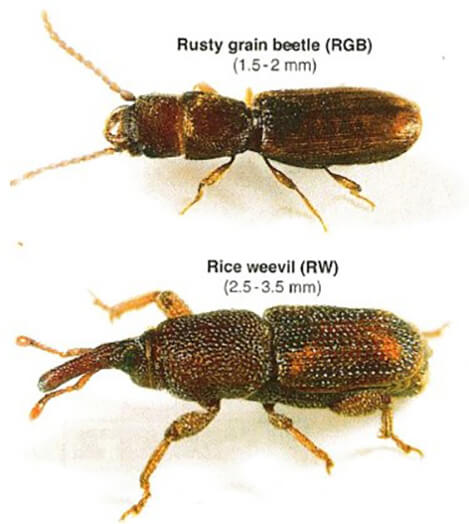
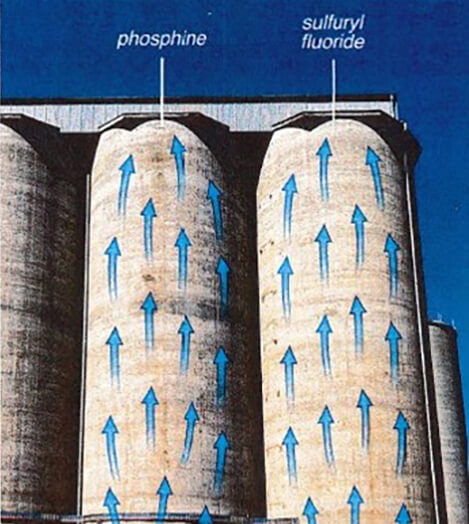
Further research will explore using refrigeration without fumigants. It will be also helpful to evaluate its effectiveness in large bunker storage. A comprehensive cost-benefit analysis is also suggested to compare costing with existing methods.
The project was partially funded by the department’s Established pest animals and weeds management pipeline program. For more information contact the Environmental Biosecurity Office.
Invasive cacti cause serious problems across Australia’s farms, landscapes, and ecosystems. Many species grow in thick, spiny thickets that block livestock from feed and water. Their sharp spines injure animals, damage hides and fleeces, and make shearing unsafe.
In Australia, biological controls (biocontrol) are used to manage invasive cactus species. It is a proven, safe, and sustainable approach. However, not all cactus species respond to biocontrol alone. Hence, the combination of control methods is required to improve results.
The Queensland Department of Agriculture and Fisheries aimed to develop cost-effective, farm-ready methods for landholders to reduce the spread and impact of invasive cacti. The focus was on Opuntioid and Harrisia cacti, which are among the most damaging species in Queensland and other parts of Australia.
Researchers tested four existing biocontrol agents already used in Australia. Three cactus species responded well, showing strong control potential. Some cactus species, however, were not suitable hosts and required different strategies.
The project also tested the combined effect of biocontrol and mechanical removal on tree pear (Opuntia tomentosa). Mechanical methods such as cutting or slashing improved microclimates for insect survival. These conditions helped the agents establish and remain effective in both felled and standing plants. Predation also played a role, influencing how well the agents survived over time.
Researchers rediscovered the brown prickly pear stem borer (Lagocheirus funestus) in southeast Queensland. First introduced in the 1930s, it was believed extinct after years of drought. This beetle causes severe damage to tree pear, often breaking large branches or toppling whole plants. Its reintroduction could strengthen current biocontrol programs.
Further investigations explored control options for Harrisia martinii. Researchers examined both insect biocontrol and livestock grazing impacts. Dorper sheep were found to feed readily on H. martinii, reducing plant density over time. Tests showed that H. martinii has more carbohydrates than nearby native plants, so sheep prefer to eat it. GPS tracking revealed that sheep avoided areas with dense shrubs such as African Boxthorn and Mimosa bush. These areas may need additional control methods.
Combined sheep and cattle grazing reduced flowering and fruiting in Harrisia, limiting the spread of new plants. Examination of the scats of potential Harrisia seed dispersers, showed that seeds eaten by sheep and pigs were non-viable. Researchers also found that young Harrisia plants were highly sensitive to fire. Mature plants, however, could regrow from underground tubers within five months after burning.
This research highlights the value of using an integrated management approach to reduce the impact of invasive cacti. Combining biocontrol, grazing, mechanical removal, and fire helps control invasive cacti effectively.
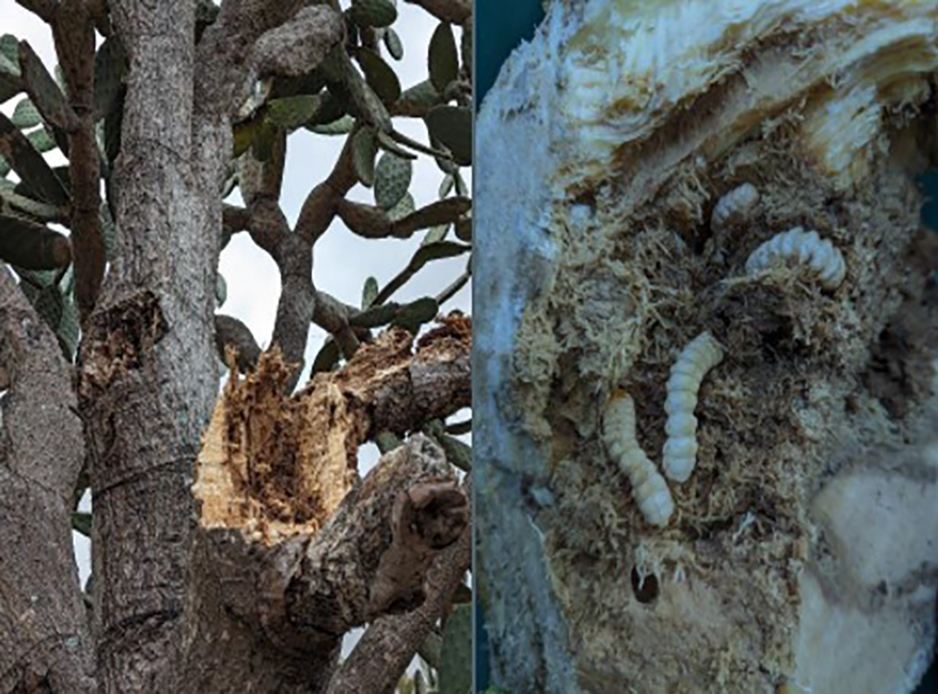
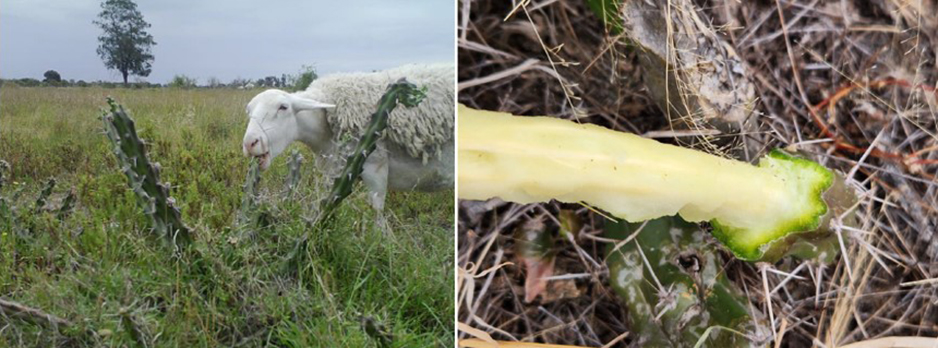
The findings from this research will be compiled into booklets and fact sheets to guide land managers. Knowing the strengths and limits of each method is key to managing weeds well. This shows why flexible, combined approaches are important.
The project was partially funded by the department’s Established pest animals and weeds management pipeline program. For more information contact the Environmental Biosecurity Office.
The Fall Armyworm (FAW) is a destructive pest in Australia. It is one of the world's top ten plant pests attacking more than 300 important crops like corn, sorghum, and sugarcane. It spreads quickly, causing severe damage by feeding on leaves, stems, and grains, leading to major losses for farmers. It reproduces rapidly and can develop resistance to pesticides. Hence relying only on chemicals alone is not a sustainable solution. Effective management requires an integrated approach. This should include monitoring, biological control using natural predators, and responsible pesticide use.
Murdoch University have developed a new control method using synthetic amorphous silica (SAS) powder with a novel application technology. They aim to make this product commercially available in the future.
SAS powder is a nontoxic and residue free alternative to current chemical control. SAS powder is highly water absorbent. It kills insects by dehydrating them causing their exoskeleton to breakdown, thereby breaking the pesticide resistance development cycle. The powder can be blown onto the effected plants, killing all FAW on their exterior, and preventing their reinfestation for 10 days. SAS powder does not affect plant growth. Application of the SAS powder has been patented as a “A Method for Controlling Field Insects - PCT/AU2021/050917”. This new technique has the potential to be an effective addition to the integrated pest management toolbox.
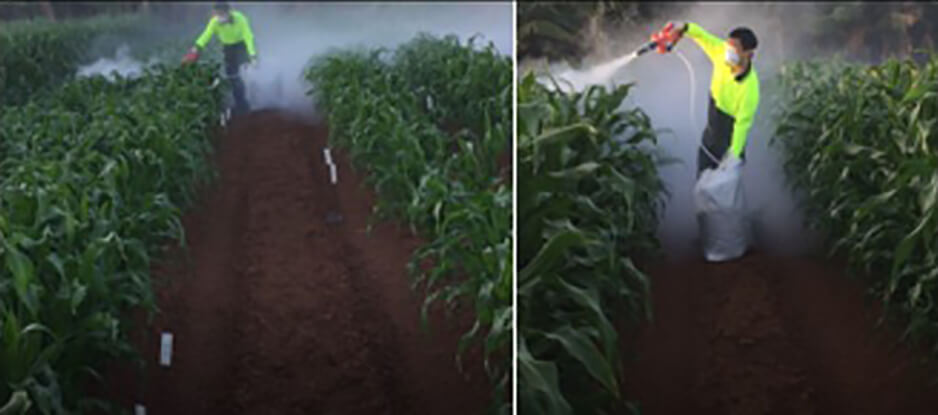

This project also developed an AI system that can tell the difference between Fall Army Worm (FAW) and non-FAW larvae and adults. This to allow for quick detection and management of FAW infestations.
Murdoch University has developed a strategic roadmap. It focuses on further research and development and on the commercialisation and marketing of the patented SAS product and application technology. They will seek a commercial partner to help deliver the product.
The project was partially funded by the department’s Established pest animals and weeds management pipeline program. For more information contact the Environmental Biosecurity Office.
